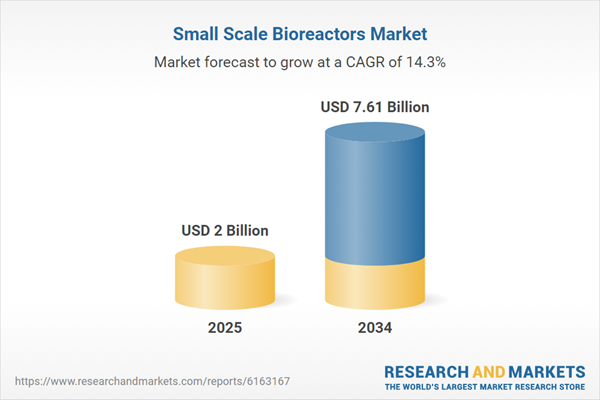Small Scale Bioreactors: Introduction
Small scale bioreactors are containers specialized to be used for cultivating microorganisms or living cells under accurately controlled conditions, facilitating the production of various molecules. These bioreactors are particularly valuable as essential tools for process development and optimization in pharmaceutical and biopharmaceutical studies. Typically designed for smaller-scale production, they come in a range of sizes, spanning from a few millilitres to 5-10 litres. Notably, small scale bioreactors offer economic advantages, requiring less labour than their larger counterparts.These bioreactors are often employed as cost-effective miniaturized alternatives that effectively replicate almost all the functional capabilities of bench-scale reactors at significantly reduced volumes. Small Scale bioreactors have the capability for parallel operation enabling a cost-efficient series of experiments to be conducted. A few examples of small scale bioreactors include shake flasks, microtiter plates, and benchtop bioreactors. Additionally, small scale bioreactors come in both reusable and single-use variants, with the latter employing disposable bags in lieu of traditional reusable steel vessels.
Global Small Scale Bioreactors Market Analysis
The global market for small scale bioreactors is witnessing notable trends that are shaping its trajectory in recent years and are expected to continue in the forecast period. One significant trend is the substantial surge in sales of small scale bioreactors in 2020 and 2021, primarily driven by numerous businesses expanding their facilities to conduct crucial research and development for COVID-19 vaccines. This heightened demand for bioprocessing equipment played a pivotal role in the market's growth. Furthermore, with ongoing global immunization campaigns and the persistent demand for vaccines, the sales of small scale bioreactors are expected to maintain their upward trajectory.Government authorities have also made substantial investments in enhancing biopharmaceutical research and expediting vaccine development, further influencing the Small Scale bioreactors market growth. These investments are geared towards advancing the capabilities of bioprocessing equipment, including small scale bioreactors, to meet the increasing demands for vaccine production and other biopharmaceutical research needs. As a result, the small scale bioreactors market is expected to continue to thrive, driven by these trends that underscore the critical role of bioprocessing in addressing global healthcare challenges.
Global Small Scale Bioreactors Market Segmentations
Small Scale Bioreactors Market Report and Forecast 2025-2034 offers a detailed analysis of the market based on the following segments:Market Breakup by Product
- Reusable Bioreactors
- Stainless Steel Bioreactors
- Glass Bioreactors
- Single-Use Bioreactors
Market Breakup by Capacity
- 5 mL-100 mL
- 100 mL - 250 mL
- 250 mL - 500 mL
- 500 mL - 1 L
- 1 L - 3 L
- 3 L - 5 L
Market Breakup by Cells
- Bacterial Cells
- Yeast Cells
- Mammalian Cells
Market Breakup by End User
- Pharmaceutical and Biopharmaceutical Companies
- CROs and CMOs
- Academic and Research Institutes
- Others
Market Breakup by Region
- North America
- Europe
- Asia Pacific
- Latin America
- Middle East and Africa
Global Small Scale Bioreactors Market Overview
The global market for small scale bioreactors is experiencing robust growth driven by key factors such as the widespread utilization of small scale bioreactors in the pharmaceutical industry, coupled with the expansion of product portfolios by key players, which has significantly contributed to market expansion. These bioprocessing tools play a crucial role in the development and optimization of processes, making them invaluable in pharmaceutical and biopharmaceutical research. Small scale bioreactors typically range in size from a few millilitres to 5-10 litres and are essential for small scale production.The increasing prevalence of chronic diseases such as cancer, cardiac disease, diabetes, and hypertension has also driven the development of innovative biological therapies, contributing to the increased demand for small scale bioreactors, particularly for producing monoclonal antibodies and personalized medicines. The adoption of advanced technologies to streamline complex manufacturing processes is also boosting the demand for Small Scale bioreactors in the biopharmaceutical sector, further propelling the small scale bioreactors market growth.
Moreover, significant investments in research and development activities by key biopharmaceutical companies are expected to further propel industry growth. The rising investments in biopharmaceutical research, driven by the growing incidence of chronic diseases and the demand for novel biologic drugs, coupled with the adoption of advanced bioprocessing equipment like small scale bioreactors, are some of the key drivers fuelling the growth of the market.
Global Small Scale Bioreactors Market: Competitor Landscape
The key features of the market report include patent analysis, grants analysis, clinical trials analysis, funding and investment analysis, partnerships, and collaborations analysis by the leading key players. The major companies in the market are as follows:- Sartorius AG
- Merck KGaA
- Lonza Group
- Thermo Fisher Scientific Inc.
- Danaher Corporation
- Getinge AB
- Eppendorf AG
- Miltenyi Biotec
- Solaris Biotechnology Srl
- Infors AG
- H.E.L Group
- Lianyungang Bailun Biochemical Technology Co., Ltd
- Cytiva
This product will be delivered within 3-5 business days.
Table of Contents
Companies Mentioned
- Sartorius AG
- Merck KGaA
- Lonza Group
- Thermo Fisher Scientific Inc.
- Danaher Corporation
- Getinge AB
- Eppendorf AG
- Miltenyi Biotec
- Solaris Biotechnology Srl
- Infors AG
- H.E.L Group
- Lianyungang Bailun Biochemical Technology Co., Ltd
- Cytiva
Table Information
| Report Attribute | Details |
|---|---|
| No. of Pages | 350 |
| Published | July 2025 |
| Forecast Period | 2025 - 2034 |
| Estimated Market Value ( USD | $ 2 Billion |
| Forecasted Market Value ( USD | $ 7.61 Billion |
| Compound Annual Growth Rate | 14.3% |
| Regions Covered | Global |
| No. of Companies Mentioned | 13 |









